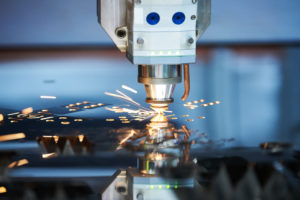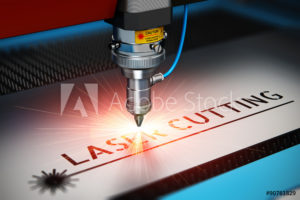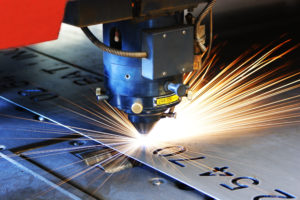Union Machine offers a wide range of manufacturing, design, and prototyping services. We use best-in-class machinery to provide our clients with exceptional service and results. One of our most common services is laser cutting—a material cutting solution that uses focused laser beams to create precision cuts on a variety of material types.
Laser cutting is incredibly versatile. Since the development of lasers in the 1960s, the technology has become a staple of manufacturing. Laser cutting offers rapid speeds, minimal waste production, and incredible scalability—especially when combined with computer numerical control (CNC) technology.
The team at Union Machine has worked with businesses in sectors such as aerospace, mining, construction, medical, energy, and other industries that require close tolerances, complex geometries, or precision cutting.
Why Laser Cutting?
 Laser cutting uses a hyper-focused, thin laser beam to cut workpiece material. Most laser cutters rely on CNC-guided operation, which helps to make the process one of the fastest, most accurate, and most cost-effective ways to create complex patterns, lines, and designs. The laser cutting process is compatible with a variety of materials, such as metal, plastic, and glass. Depending on the application and need, laser cutters can also create detailed parts out of unfinished materials.
Laser cutting uses a hyper-focused, thin laser beam to cut workpiece material. Most laser cutters rely on CNC-guided operation, which helps to make the process one of the fastest, most accurate, and most cost-effective ways to create complex patterns, lines, and designs. The laser cutting process is compatible with a variety of materials, such as metal, plastic, and glass. Depending on the application and need, laser cutters can also create detailed parts out of unfinished materials.
Unlike some other cutting processes, laser cutting produces little waste. Lasers either melt or completely vaporize materials depending on the settings and type of laser utilized. This makes laser cutting ideal for projects where minimal waste or sustainability are important.
The Laser Cutting Process
 There are multiple methods of laser cutting, and the type of gas, beam, and equipment utilized depends on the specific project needs.
There are multiple methods of laser cutting, and the type of gas, beam, and equipment utilized depends on the specific project needs.
Depending on the type of laser cutting machine, this beam could be generated by gas in a pressurized gas assembly or via a rare earth, such as neodymium. Next, a focusing lens at the end of the laser cutting head increases the intensity of the laser beam, which is directed to the work surface using mirrors. Finally, manual operation or CNC automation guides the laser across the work surface to produce cuts.
This entire process is thermal-based and requires no direct contact with the work surface. Lasers can be precisely controlled to generate specific types of cuts, including fusion cutting, evaporation cutting, chemical degradation cutting, and oxidation cutting. All of these cutting types produce little waste and create incredibly smooth, polished, and accurate lines.
The laser beam is guided across the material via a moveable laser cutting head, by moving the workpiece itself across a stationary beam, or some combination of the two. Depending on production needs, materials can be grouped onto the cutting surface for faster throughput. Laser cutting can start either at the edge of a material or on the material itself. In the case of the latter, the focused beam starts by burning a hole in the material and then using that hole as a guiding point to cut through the rest of the material.
Laser Cutting Benefits and Capabilities

- Non-contact process. Laser cutting doesn’t require any physical contact with the materials. This means a smaller heat-affected zone (HAZ) than other conventional cutting processes, resulting in reduced material distortion.
- Multiple material choices. While EDM requires electrically conductive materials and metal machining is typically best-suited for specific alloys, lasers can be used on materials across a broad spectrum, such as cloth, plastic, gemstone, paper, metal, and glass. There are materials that laser cutters can’t cut due to safety reasons—such as polystyrene foam, fiberglass, and PVC, for example—but the majority of materials are compatible with laser cutting.
- Precision. Laser cutting can produce extremely small cuts (down to 0.011”) at tolerances of +/- 0.002”.
- Repeatability. Since laser cutting can be used with CNC machining, it offers incredible repeatability and accuracy with high automation potential.
- Speed. CNC laser cutting is typically faster than water jet cutting or other conventional machining processes, facilitating high-volume production of parts with complex cuts.
- Reduced waste. Compared to conventional machining, laser cutting produces less waste during the cutting process. CAD files and CNC machining allow laser cutting to group products, further reducing the amount of waste produced. Laser cutting doesn’t actually cut materials, but instead evaporates or vaporizes them. This produces less waste than machining methods that physically cut materials and leave slivers of product waste in bins.
- High-quality edges. Laser cutting produces incredibly high-quality cuts. There is typically no need to finish or treat laser-cut edges.
Laser Cutting Applications and Differentiators
Since laser cutting is a versatile machining method that’s compatible with a plethora of materials, it’s used across industries to create best-in-class finished products. We’ll cover a few key applications, but this list is by no means exhaustive.
Applications
Laser beams can be adjusted to fit a wide range of material types and thicknesses, and the minuscule width of lasers can cut complex, unique, and awkward shapes, corners, edges, and patterns.
- Sheet metal is the most common material cut by lasers. Since sheet metal is thin and is often used for production batches, it presents an ideal situation for laser cutters.
- Aerospace. The aerospace sector uses laser cutting to create holes for airflow in combustion liners and engine bafflers. Laser cutting is also used for precision cuts in the fabrication of a variety of engine and rotary components.
- Medical. The medical sector relies on precision laser cutting to create highly accurate components used in medical devices, as well as other medical equipment such as tools and stents.
- Energy. The energy sector relies heavily on laser cutting for the production of solar energy cells, semiconductors, and more.
Differentiators
Using our 5-axis laser cutting machine, the team at Union Machine excels at cutting at compound angles for specific airflow patterns. We also specialize in cutting complex, awkward, and dynamic angles and patterns because our machine uses hemispheres and specific contours rather than a flat bed.
We can handle a variety of production volumes, including prototypes. Our portfolio spans industries and part types, and we leverage our amazing in-house talent to manufacture parts that always meet and exceed expectations.
Laser Cutting Services from Union Machine
Laser cutting uses high-powered, focused, and thin laser beams to vaporize or melt materials to specific dimensions. Since lasers are easily controlled via CNC G-code, they can create precise cuts with tolerances of +/- 0.003”. Laser cutting offers an ideal production method for applications that require complex precision cuts.
In addition to laser cutting, Union Machine is capable of providing Laser Drilling services as well. For more information regarding our capabilities for this niche specifically, please visit our Laser Drilling page.
At Union Machine, our low-cost, rapid-delivery model puts efficiency, speed, and quality at your disposal. Contact us to see how our laser cutting solutions can help your project.
